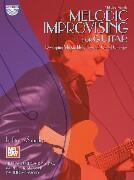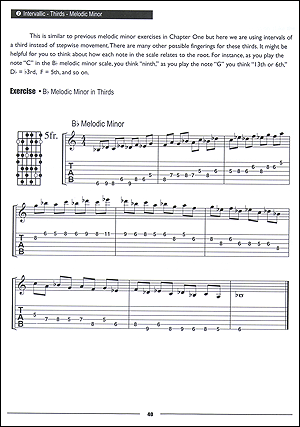SAUNDERS BRUCE, MELODIC IMPROVISING FOR GUITAR. CD TABLATURE
SAUNDERS BRUCE, MELODIC IMPROVISING FOR GUITAR. CD TABLATURE
Developing Motivic Ideas Through Chord Changes
Product Description:
"Melodic Improvising" is a systematic, detailed method to help the intermediate to advanced guitarist create melodies over harmony. Using techniques developed through his 15 years of teaching improvisation at the world-renowned Berklee College of Music, Bruce Saunders' book teaches guitarists the same techniques used by pianists and brass and woodwind players to create melodic solos; a necessary book for any guitarist wishing to play "outside the box."
Product Number: 20216BCD
Format: Book/CD Set
ISBN: 0786668458
UPC: 796279089869
ISBN13: 9780786668458
Series: Non-Series
Publisher: Mel Bay Publications, Inc.
Introduction
One of the most common problems I encounter with guitarists inexperienced with playing over chord changes is continuing one idea, theme, pattern or motive through the changes. Often, the guitarist will stop the idea or line when the harmony changes and begin a completely new idea with no relation to the previous theme, perhaps because guitarists are accustomed to playing "shapes" and approaching improvisation visually rather than musically.This is not to say that the guitarist should ignore any visual cues, but that he/she should not rely exclusively on a box or grid, etc. With this in mind, I have compiled a series of exercises that, when used correctly, might help students develop more consistent melodic lines and phrases. Whenever possible, I will try to give as many visual devices as possible to help you make the transition from sight to sound. The student is encouraged to go well beyond the boundaries of what is presented here with his/her own patterns, exercises and development. Remember that the most crucial aspect of this concept is continuing the pattern or line through the chord changes. Some of the notes have more weight than others. For instance, the chord tones contained in the scale will sound much stronger than the non-chord tones. Nonchord tones landing on downbeats have much less weight than chord tones. It is also immediately apparent when the pattern or scale is broken. There are certainly many scales other than the ones I have picked that you could use on certain chord qualities. In some instances I used scales that might be more familiar to beginning and intermediate players. Try all of these exercises with other scales, other patterns and other intervals. Listening closely to great improvisers is very important. Masters of jazz improvisation such as Wes Montgomery, Louis Armstrong, Dewey Redman, Miles Davis, Sonny Rollins, Charlie Parker, Jim Hall, John Coltrane, Joe Henderson, Wayne Shorter, et.al. might share some common improvisational techniques but the most important shared trait would be simply an ability to make music. For instance, a strong time feel, a personal sound, great harmonic sense and something else that is undefined but could be called genius. Specific notes may be important but great melodic choices alone don't necessarily mean a great solo. For obvious reasons, this method will explore only a few of the ways notes and rhythms are put together. The method presented here is totally inorganic and to improvise mechanically using only patterns such as these will produce an unmusical, stiff solo. The student should practice inorganically and improvise organically. You should have some way of practicing these techniques with chordal accompaniment. A sequence, a loop, a tape, a recording, a friend, a gig, a trust fund to hire a rhythm section; something. It would be helpful if you can play through changes slowly at first and really explore a specific concept. In short, it's vital to hear how melodies relate to chords.
contents
CHAPTER ONE - STEPWISE MOVEMENT
Stepwise major CD
Stepwise major CD
Stepwise dominant "Isotope" CD
Stepwise dominant "Ask Me Now" CD
Stepwise minor CD
Stepwise melodic minor CD
Stepwise melodic minor CD
Mixolydian & Melodic Minor "Well, You Needn't" CD
Stepwise pentatonic CD
Mixed Stepwise F Blues CD
ETUDE I - "I Like You" (slow) CD
"I Like You" (fast) CD
ETUDE 2 - "Tell You Later" (slow) CD
"Tell You Later" (fast) CD
ETUDE 3 - "Lunar" (slow) CD
"Lunar" (fast) CD # 19
CHAPTER TWO - INTERVALLIC MOVEMENT
Thirds major CD
Major prerequisite - F and A b Major :
Thirds F Major CD
Thirds Ab Major CD
Thirds Mixed Major & Mixolydian CD
Thirds Mixed 3 tonic system CD
Thirds Melodic Minor CD
Thirds Melodic Minor CD
Fourths Melodic Minor CD
ETUDE 4 - "What Things" (slow) CD
"What Things" (fast) CD
ETUDE 5 - "If Not For You" (slow) CD
"If Not For You" (fast) CD
ETUDE 6 - "Little Feet" (slow) CD
"Little Feet" (fast) CD
CHAPTER THREE - PATTERNS, TRIADS &
CHORDS THROUGH CHANGES
Major triads & Dominant chords CD
Major triads & Dominant cycle CD
Major triads & minor chords CD
Triads & Altered Dominant CD
Triads & Dom (b9b13) chords CD
Triads & tritone subs CD
Triads with minor and diminished chords
Triads (close) minor & diminished CD
Triads (close) minor ii-V-i CD
Triads (close) "Solar" (slow) CD
"Solar" (fast) CD
Triads (close) F Blues (slow) CD
F Blues (fast) CD
Triads (close) Bb Blues (slow) CD
Bb Blues (fast) CD
Triads (close) "Serenity" (slow) CD
"Serenity" (fast) CD
Triads, arpeggios & Melodic minor CD
Triads, arpeggios & Melodic minor CD
Open triads & minor ii-V"s CD
Open triads & minor ii-V"s CD
Chordal subs. & arpeggios CD
ETUDE 7 - "It Happens" (slow) CD
"It Happens" (fast) CD
ETUDE 8 - "Stella Artois" (slow) CD
"Stella Artois" (fast) CD
ETUDE 9 - "Blues for Joe" (slow) CD
"Blues for Joe" (fast) CD
ETUDE 10 - "Side Step" (slow) CD
"Side Step" (fast) CD
APPENDIX MORE INTERVALS (ADDITIONAL INTERVALLIC STUDIES)
Melodic Minor
Harmonic Major
ABOUT THE AUTHOR







